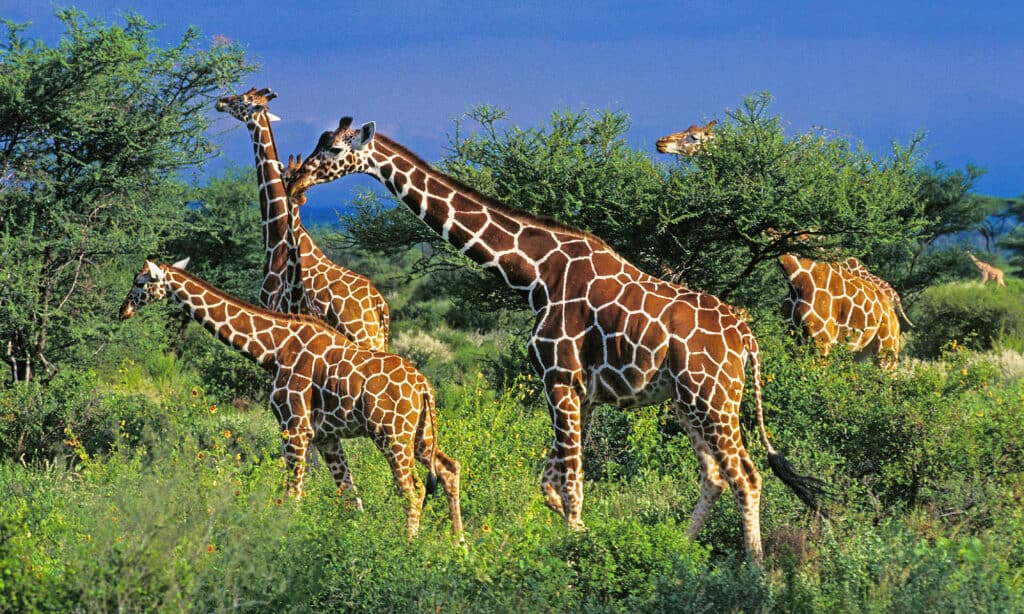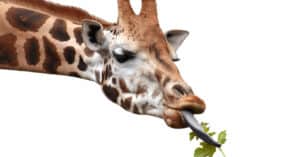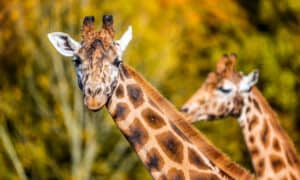Giraffes are some of the most elegant and graceful mammals. Their slender bodies and towering height make them look incredibly unique, which is probably why they are one of the most well-loved animals! Watch below as a mother giraffe’s protective instincts causes its baby to become a lion’s next meal.
The video begins by showing a scenic landscape with a mother and baby giraffe. After a few seconds, a lion walks into the shot, clearly looking to hunt down the baby giraffe. In an attempt to protect her baby, the mother pushes it forward. While following its mother’s actions, the baby falls forward down into a small ditch.
Watch the Unfortunate Event
Helpless, the mother can only watch as the tiger runs in to grab the baby giraffe. With a few powerful movements, the tiger latches on and begins taking bites at the baby. The clip ends by showing the lion dragging away the giraffe, pleased with his exceptionally large catch of the day.
Giraffe Family Dynamics

Giraffes are a fairly social species that form herds to help gather food and protect each other.
©iStock.com/slowmotiongli
Like many other animals, giraffes have a pretty standard family arrangement that is dictated by the age or sex of each animal. This is likely because giraffes need order and regularity to be prepared to forage and defend against predator attacks.
After an extremely long gestation period of 13-15 months, mother giraffes will typically give birth to one baby. For roughly the first 15 months of their lives, baby giraffes are dependent on their mothers for food and protection. After that period though, most male giraffes will leave to form social groups of their own.
In contrast, young females more commonly stay in the social group in which they were born to. In odd cases, they move to a different group within the same general area.
As for the video below, the young giraffe is likely in a period of their life that requires parental care. This is why the mother was so quick to act defensively and protect her young!
Why Do Giraffes Look the Way They Do?

Giraffes are the tallest mammals on Earth.
©Eugen Haag/Shutterstock.com
Being such unique animals, it sometimes seems that different animal features were just combined to form the giraffe. For instance, their long neck, long legs, hooves, and unique spots all seem out of place on a single animal. Why do they have some of these interesting traits?
Their long necks have been a widely debated trait within the scientific community in terms of usage, but there seems to be two main arguments:
- Their necks evolved to help them reach tall growing plants.
- Their necks were adapted as a form of sexual selection in male-to-male fighting.
In addition to their necks, giraffe spots are another unique trait. Compared to necks, spots seem to be more understood biologically. Most scholars agree that their spots act as a form of disruptive camouflage that allows them to blend into their complex savannah habit. Additionally, some also pose that spots may be a social indicator that allows individuals to tell each other apart.
How Big Do Giraffes Get?

Giraffes are the tallest known land mammal.
©iStock.com/Jonathan Ross
Giraffes hold the title of being the tallest known land animal. Female giraffes can reach heights of up to 14 feet and weigh as much as a staggering 1,500 pounds!
In contrast, males can tower up to 18 feet and tip the scales at 3,000 pounds. At this impressive height, a giraffe can easily peer into a second-story window of any given building.
While a giraffe may be able to fight off a single lion in a one-on-one encounter, a single giraffe would fall prey to a pride of lions if surrounded. Lions mostly kill giraffes when they are young as they are easier targets.
Thank you for reading! Have some feedback for us? Contact the AZ Animals editorial team.








